Fires
Always use caution when you start a fire in the wilderness. You are surrounded by fuel. Remember big fires start small. In dry weather, even without restrictions, it is a good idea to forgo a fire and do all you’re cooking on a camp stove.
A campfire is nice in the wilderness. In some cases (hypothermia) it can be a life saver. The atmosphere that it creates is warm and comforting. But use common sense when you build a fire. The wilderness is not the place for bonfires. Keep it small and manageable. The bigger the fire, the greater the potential is for windblown embers.
Your fire needs to be attended at all times. Before you leave check the fire pit to assure the fire is out.
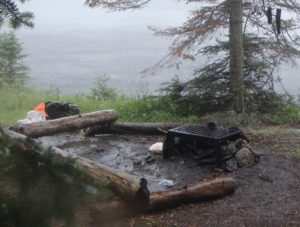
Wet Start
Campfires
- If you want a campfire you will have to find firewood. Use only deadfall or dead trees.
- Use shredded paper or cardboard from food packaging or look for anything dry; pine needles, cedar leafs, deciduous leafs, or duff (dry vegetation covering the ground).
- Place the tinder in the fire grate; if you are using a fire stick place it in the middle of the tinder.
- Build a tent of twigs and small sticks over the top of the tinder leaving a small window to insert a lit match.
- In damp weather you may choose to add a little Boy Scout water to the kindling.
- Once the tinder and kindling are burning add progressively larger pieces of firewood until you establish a good bed of hot embers.
- Keep the fire small and within the fire grate.
- Smaller fires are safer and require less wood to maintain.
- As the night winds down stop feeding the fire and watch as the fire dies out.
- In dry or windy weather douse the remaining embers with water.
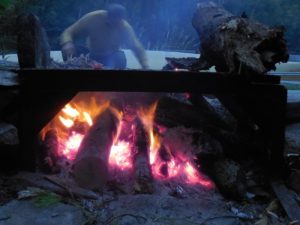
Warm finish
Starting a Fire without Matches
Matches, even water proof matches, and lighters can get wet and will no longer work. If you are on a longer trip you should be carrying other forms of ignition. Flint and steel is probable the most popular. You can also bring a magnesium block and tinder. Some of your choices for tinder are cotton balls, dryer lint, and charred cloth. All tinder needs to be protected from moisture, film canisters work great. The forest can also provide you with dry duff (vegetation), pine straw, cedar leafs, cedar bark scrapings, and birch paper.
Start by building a tent like structure of small kindling in the fire pit. Place some tinder inside the kindling. Leave an opening in the front to insert the lit tinder. Have a supply of extra tinder and kindling on hand to feed the fire as it grows.
To start a fire:
- Find a piece of birch bark or similarly dry piece of bark
- Make a nest of tinder and place it on the bark. You can get tinder by:
- Scraping the bark of a cedar tree o Shredding fine birch paper from bark
- Collecting dry cedar leafs
- Collecting dry pine straw
- Collecting dry duff
- Unravel and fluff the strands from a piece of organic rope
- In this nest place;
- Magnesium shavings
- Charred cloth o Dryer lint
- Cotton balls/pads
- Use an igniter to direct a spark into the center of the nest
Once you get an ember gently blow on it until the tinder ignites. This may take more than one attempt. By placing your nest on a piece of bark you can pick it up making it easier to blow on and place in the fire pit. When the tinder ignites gently place it in the kindling tent you built. Feed progressively larger pieces of wood as the fire grows.
Experiment with different materials and methods to start a fire. You may not always have the materials you are used to. After a while you will develop your own technique.
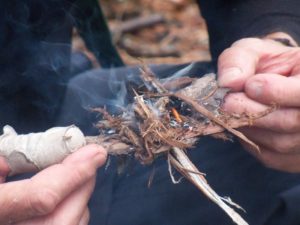
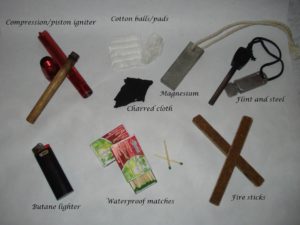
Making Charred Cloth
The recipe for making char (charred) cloth is simple. Start by cutting cloth from a tee shirt into 2” squares. The higher the percentage of cotton in the cloth the better the char will be. Follow the instructions below.
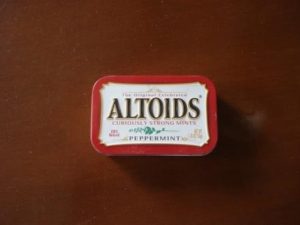
Use an empty Altoids or similar tin. Sterno cans work well also,
just punch a hole in the lid
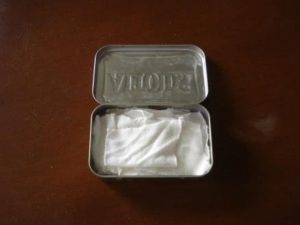
Layer the cloth squares in the tin
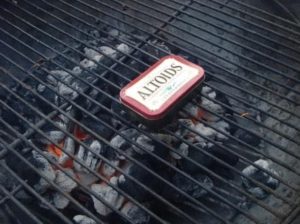
Loosely close the lid.
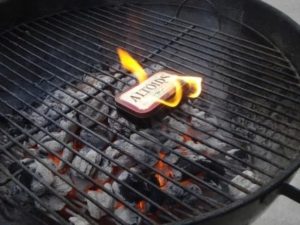
Allow the gases from the cloth to Place the tin on a grill or fire grate. burn off.
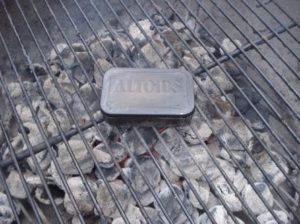
Leave on the fire until all visible smoke and fire have stopped, about 10-15 min.
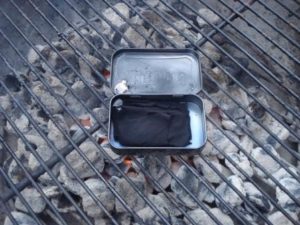
Open the top and check to see that all pieces of cloth are charred through.
Allow to cool. You can leave the char cloth in the tin and place the tin in a water proof bag. Or you can place the cloth in a water proof container, film canisters work great
.
